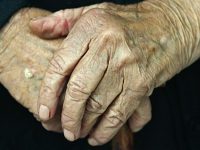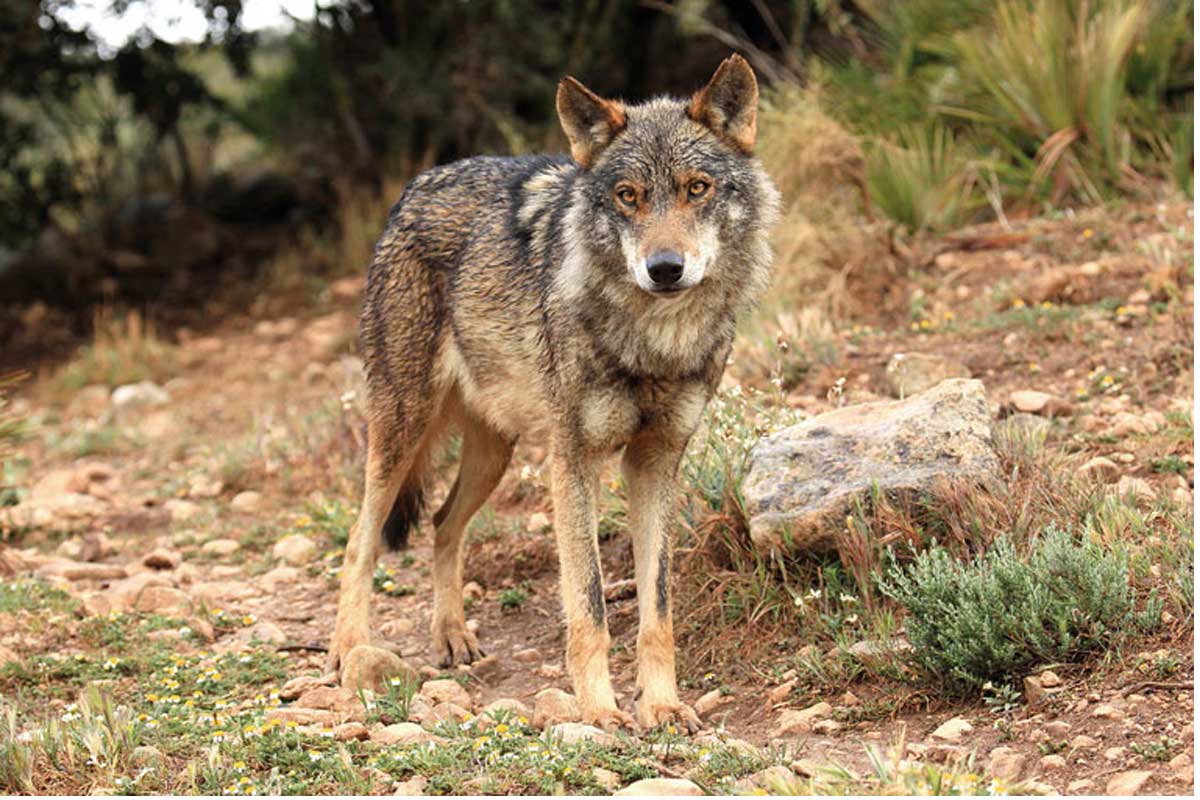
Our contributor Jaume Benaiges located documental evidence of a tragedy in the Pauls parish archives, not knowing they were part of a series of victims previously attributed to man-eating carnivores. Events took place in the massif of Els Ports and turn out to be difficult to evaluate 150 years later. It is necessary to analyse more cases from Catalonia and especially France, where several deaths because of bêtes (beasts) still provoke debate and attract media attention.
A puzzling chronicle
In the March and April (1908) issue of the Journal of History and Geography of Lower Aragon, we find:
The White Wolf of the Mountain Passes of Beceite.- Marín y Vidal, writing about Peñarroya in his book La Provincia de Teruel (The province of Teruel), pg. 147, says: “In the year 1835 a hyena appeared in the mountain passes of Beceite that the folks named ‘The white wolf’, and it was for some years the dread of all the villages around the aforementioned range. The beast entered the cemeteries and exhumed the corpses, and moved closer to villages and attacked the children. In Peñarroya it made four victims in different occasions. The last one was a boy of 14 who died at the claws of the beast on May 3rd 1839. The population panicked, all the huntsmen chased the savage beast and D. Juan Antonio de la Torre, one of the most distinguished people of Peñarroya and the best marksman in the country, stroke it dead in the canal of En Pavía.
José de la Torre, son of Juan Antonio, was 13 years old when his father killed the mysterious beast. Later he would write a document where he listed the villages affected between 1835 and 1839: Pauls, Arnes, Miravet, Horta de San Juan, Cretas, Torre del Compte and Peñarroya, ending the paragraph with an etcetera that only sets more enigmas.
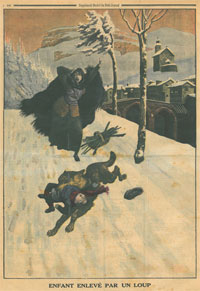
In 1914, a French supplement, Le Petit Journal, still published this drawing with the text: «Boy captured by a wolf». Due to the harshness of winter colds there were also cases like the one above. They happened somewhere in Aragon, and European gutter press made full use of it.
He mentions three more child victims with the dates and places of the attacks, with the names and information about their parents. He reports about a girl and a boy, both 9 years old, and another 14-year-old boy. Another girl was only injured.
Five renowned hunters organized a raid to try to kill the animal, from Cap de la Vinyassa to the river of Canal. The father of the chronicler was the first one to see it. As he saw it fifty-four paces away, he shot a bullet that pierced its body.
The most curious thing in the document is when later it was discovered that the beast was actually a hyena that escaped from «horse-breakers» or circus tamers.
The problem should have ended taking down the exotic beast of a hypothetical circus, although we could question a lot of details if we had more information. But the document found recently in Pauls encourages us to devote our attention to those six victims. Even more due to the fact that in the register the deaths were attributed to wolves by the priest of the moment, Ramon Valls. Some priests leave out the cause of death, except when they had not received the sacraments. On the contrary, here all the causes are described, even though the description feels rather laconic.
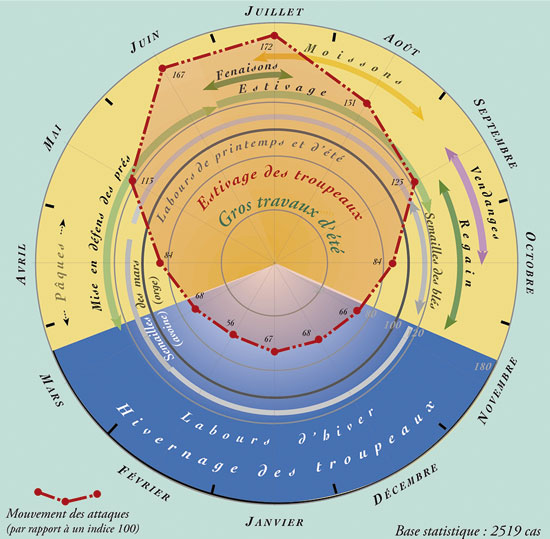
In this graphic, published in France, the months with more human victims (red line), correspond to spring and summer months (in yellow), coinciding with the cases in Pauls and most of the work in farmwork./ Graphic: Jean-Marc Moriceau
The victims from Pauls
Historians claim the origin of parish registries was in 1348, in the wake of the avalanche of deaths because of the Black Death. Religious ceremonies were celebrated so often that a control of payments had to be set. Even if there was no present intention for future generations to remember some events, a lot of priests sensed the convenience of this and thanks to them we have valuable data for research. Take for instance the data from Pauls mentioned in the subheading.
«It is not strange that predators felt attracted to villages where there was a different kind of cattle, leftovers and food smells, or their decision to feed on humans»
On June 11th 1838, on the way to San Roque, over the Freginal de la Retora, «the relics or mortal remains of a corpse, with the throat cut open and partially devoured by a wolf» were found in the morning. They belong to 7-year-old Juliana Cortilla Fandos. On August 7th 1838, in Solana d’Emperia [sic], someone located the remains «that the wolves did not eat […] and it was established that it was Cosme Tarrega Celma», a young man of 13. Ten days later, on August the 17th 1838, the body of Josep Sanz Lluís was buried. He was found dead on the fields «just below Agustí». The death cause might have been the same as in the other cases, but the priest did not write it down. Or may it be that the cause was not so clear for him? The victim was, it seems, 14 years old. On August 24th 1838 it is written that Tomasa Laloma Martínez «had her throat torn by a wolf on the land of her parents called the Coma and barely out of their sight». She was 14. Father Valls considers in this occasion that such a dramatic death requires more precision from his notation. On September 13th 1838 a new 9-year-old fell victim of the beast. Francesca Sanmartí Gracià «had her throat ravaged by a wolf in the ravine of Les Ferreres».
During the following months, maybe because of the success of the raid in Peñarroya, there will not be any more cases. However, one last fatal outcome was still to come. On May 28th 1839, eight days after killing the supposed hyena of Matarraña, 7-year-old Benet Gabriel Viña was buried after dying because of a «wolf bite». The text does not state where it happened, although it can be deduced that he was gravely injured before. This is the only case in which a victim had a «funeral mass» and received the «Holy Sacrament of the Extreme Unction». The Anointing of the Sick was then an in extremis unction, administered when death was close. The others were deposited directly in the cemetery. It was only their remains and we can often read «of Sacraments he received none».
With every case in the village, the texts do not make any concessions; the beast is not called «white wolf», nor «hyena», nor «fiendish beast», although we could suspect the people on the area would be terrorized. In such circumstances, the only way to understand why children kept risking the consequences of venturing into the surroundings is the fact that farm work was essential. We might understand this nowadays as irresponsibility on the part of the parents, unless this kind of misfortune was assumed as inescapable. We know today that driving a car has risks but we keep doing it.
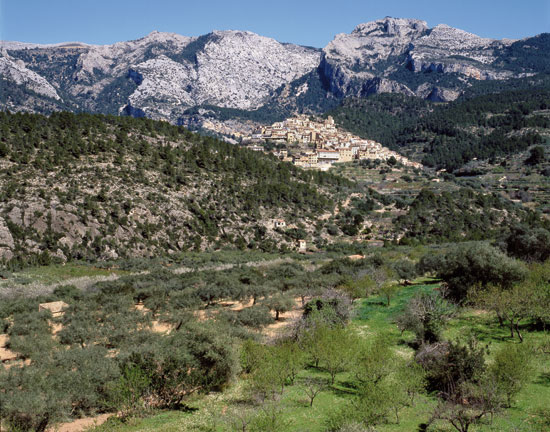
Pauls is a beautiful town due to its location and incline. It looks like it wanted to escape from the definition of riverside location./ Photo: Ernest Costa
Humans and wolves in a never-ending struggle
In order to be able to occupy new productive spaces that were occupied by predators, the fight of our ancestors, predators themselves, had to be cruel and painful for generations, but humans did not have enough with surviving. We devastated the land until many species disappeared. One of the species affected was the wolf, and in the Iberian Peninsula, it is not even a century since it was wiped out of the Mediterranean regions and even further. Without memory of the ages when it was considered usual here, we lost a vast number of guidelines on how to behave to prevent accidents and defend ourselves, although people often just reacted outraged by harm, or resigned to fatality and did nothing. There was a whole world of strategies and misfortunes, as well as attitudes to face predators and survive or to risk your life to get more resources. People often gave their lives because the intention of getting richer left them more exposed.
«The only way to understand why children kept risking the consequences of venturing into the surroundings is the fact that farm work was essential»
In the 20th century, the trail of disgrace would be forgotten, buried with the memories of old men and women, who retired to refuges or were engulfed by the industrial suburbs of many cities. Development was out of control and overlooked any environmental consideration, although we already longed for contact with nature and its values. Soon a kind of nostalgia, maybe bucolic, would start to appear. The wolf was in imminent danger of extinction in a great part of Europe and conservationist movements wanted to give another try to co-existence with the most legendary beast in the northern hemisphere. Recovery actions were to be implemented and the purpose would be to save Canis lupus. Despite human truce, it is still difficult today to take it out of the lists of endangered species, but some populations in different countries have recovered and are spreading.
To help these initiatives, perhaps out of good faith or historical ignorance, some people appeared who staunchly denied any evidence of human victims attributed to wolves. Some data is being found also in Catalonia, although they are sparse, maybe because they have not been researched enough.
We have to ask ourselves: Could a hyena live for 5 years in Els Ports? Would it be an albino animal? Did the circus in the chronicle really exist? Why did people, who really knew the animal at that point, call it the «white wolf»? Or was it a unique albino wolf, or with light-coloured fur due to old age? Could it be a wolf-mastiff crossbreed, or a feral dog?
We cannot diagnose without any more evidence. We must be aware of how people charged wolves with crimes to get some sort of impunity, as that practice was real and is well documented, and kept happening until the arrival of modern criminology. We could obtain hair, saliva or faeces samples of every predator to analyse the DNA and decide who was the real responsible.
An expert opinion
We wanted to ask Jean-Marc Moriceu about the events of Els Ports. He is a professor in the University of Caen, in lower Normandy, and an expert in human victims attributed to beasts. His books open the debate with the publishing of a lot of French registries similar to the ones in Pauls. According to him, «it is a very dangerous wolf, with an unusual behaviour».
«Despite human truce, it is still difficult today to take it out of the lists of endangered species, but some populations in different countries have recovered and are spreading»
Professor Moriceau gives his opinion in detail: «The naming of ‘hyena’ is generic to describe any wild animal that attacks humans and has a different behaviour from the local predators. In four cases analysed in 18th century France (and as late as 1814), popular naming was ‘hyena’ to focus on the aggressor and isolate it from the conduct of others of its sort. In the case of Catalonia, unless the exact origin of the hyena and the identity of its owner were found (it does not seem to be the case) we accept the popular belief that represents a psychological contrast with the usual behaviour of the predators in the region, that is, wolves. In short, unless new evidence appears, I believe the alleged hyena is a man-eating wolf».
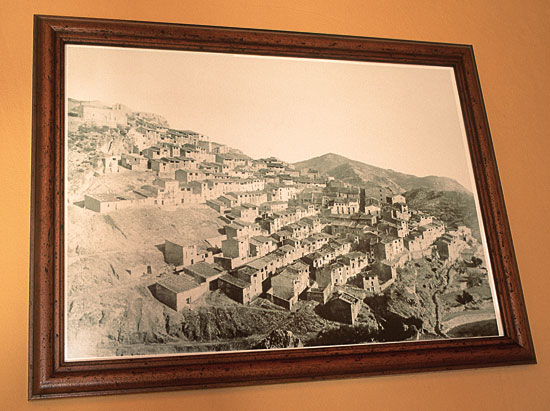
Image of Pauls from 1925. The population were mainly farmers. Some of them may even remember the events we are detailing here./ Photo: Ernest Costa
Evidence for written history
There have been official documents in Catalonia, with significant content because it shows how some wolves could get used to human flesh. In October 1816 the captain general organized raids because there were «people bitten by wolves» around the city of Barcelona. They said rabid wolves devoured a girl, killed two men and injured another, but if they had been in an advance state of the rabies they would not have been able to eat anything. They also ordered hunts because «even when wolves are not rabid, they seem to have acquired the habit of feeding on human flesh […] maybe due to the amount of bodies during this last war».
In regard to equally documented episodes, doctor Bonaventura Sendil published this one from eastern El Vallès in 1825:
In Vilamajor four dead between boys and girls. Three recovered, two boys and a girl, alive but severely wounded. In Monseny one boy, dead and devoured. In Santa Susana one dead and devoured. In Santa Susana, one dead and another one severely wounded, yet defended. In Palau Tordera one dead girl, and mostly devoured. In Campins one dead girl, and one boy taken, yet defended with no harm. In Collsabadell one dead girl, and one taken and severely wounded. In Vilalba Saserra one girl taken and defended with no harm.
He finishes saying that the last attack happened on March 18th against a girl, «entirely devoured, with the exception of a piece of arm and a bit of head. I notice all this damage and can offer justification whenever it is necessary».
Possible explanations
Men are not usually prey to wolves, an animal with a preference for herbivores. But its ability as an opportunistic and intelligent predator, as well as carrion eater, should not be dismissed either. They can run some risk from spring to summer if they do not have enough prey to feed their cubs. We cannot overlook the fact that the months with the highest number of victims coincide with Moriceau’s statistical studies. It was the busiest moment in the fields, crops could hide the wolves and let them stalk vulnerable prey. Without cattle, away for half a year for seasonal migration, it was difficult for litters near human centres to survive. Especially when they counted on cattle and the carrion they generate.
It is not strange, therefore, that predators felt attracted to villages where there was a different kind of cattle, leftovers and food smells, or their decision to feed on humans, given the lack of social organization and the number of corpses because of the war. There are still archives in the aforementioned villages for us to investigate. They would be useful to know more interesting details as of now unheard.
REFERENCES
Bevanger, K. and L. L. Olden, 2002. La peur du loup. Recueil d’attaques de loups sur des humains. Norsk Institutt for Naturfonskning. Trondheim, Norway.
Burnier, F., 2001. «Comment peut on vivre avec des loups sauvages?». Bulletin des medecins suisses, 11: 549-554.
Costa i Savoia, E., 2012. Paüls. Arola Editors. Tarragona, Spain.
Curto i Homedes, A. and A. Martínez Silvestre, 1999. «La presència del llop a l’antic terme de Tortosa durant la baixa edat mitjana». Acta Historica et Archaeologia Medieaevalia, 20-21: 455-475.
Manent, A., 1995. El llop a Catalunya. Memòria llegenda i història. Pagès. Lleida, Spain.
Massip i Gibert, J. M. (ed.), 2011. El llop i els humans. Passat i present a Catalunya. Arola. Tarragona, Spain.
Massip, J. M. and J. Maroto (eds.), 2011. Llops i humans a Catalunya. Del passat al present. Centre d’Estudis Comarcals de Banyoles. Banyoles, Spain.
Moriceau, J. M., 2007. Histoire du mechant loup. 3000 attaques sur l’homme en France. xve-xxe. siècle. Fayard. Paris, France.
Moriceau, J. M., 2011. Le loup et l’historien: La realité des attaques sur l’homme. Un bilan à l’échelle de la France (xve-xxe siècle). In Massip, J. M. and J. Maroto (eds.), 2011. Llops i humans a Catalunya. Del passat al present. Centre d’Estudis Comarcals de Banyoles. Banyoles, Spain.




